Vehicle Information
General Vehicle Supplies
All vehicles are equipped with the following supplies:
- Alcohol wipes
- Snow Scraper
- Fueling cards
- Trip Tips booklet 5x5
- Chevy Bolt Trip Tips
- Nissan Leaf Trip Tips
Some vehicles also include:
- Parking cards to enter and exit hubs
- Cargo blankets (in HOURCAR vehicles)
If you are in a vehicle that is missing any of these items, please contact Member Services at 612.343.2277 or info@hourcar.org.
Fleet Information
The HOURCAR and Evie fleets contain a mixture of electric, gas, and hybrid vehicles. The Evie Carshare fleet is all electric and the HOURCAR fleet includes electric, gas, and hybrid vehicles.
An electric vehicle is powered by electricity, and needs to be charged. A gas vehicle is powered by gasoline, and needs to be filled up at the gas station.
A hybrid vehicle switches between gas power and electric battery power to maximize efficiency. It can go farther on a tank of gas than a solely gas-powered car, but still needs to be filled at a gas station. The hybrid battery is charged automatically via the car's momentum, and does not need to be plugged in.
The information below defines specifics for each model of vehicle in our fleet.
Chevy Bolt
| Year | 2021 and 2023 |
| Fuel type | Electric |
| Fuel Door Opening | Door located on front driver's side of car, push on door to open |
| Charge Port Type | J1227 for Level 2, CCS for DC Fast Charge |
| Max Range | 259 miles, 180 miles in winter |
| Key | Keyless |
| Body Type | Hatchback |
| Backup Camera | Yes |
Chevy Bolt Gear Shift
To shift into gear on a 2021 Bolt, you press the button on the left side of the gearshift and move the shifter to the appropriate gear. All Evie Carshare Bolts have this gearshift.
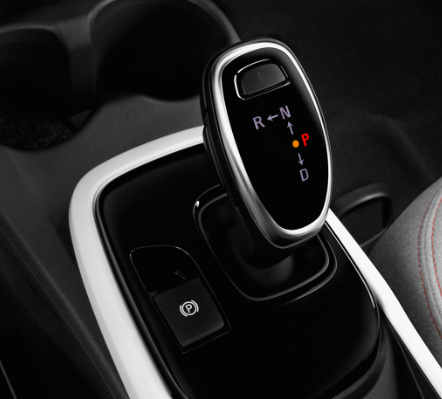
The Evie and HOURCAR fleet also includes 2023 Bolts. To shift into gear on a 2023 Bolt, you press the button associated with the gear. For Reverse and Drive, the silver button above the letter selects the gear.

Chevy Bolt Regenerative Braking
Regenerative braking (regen) means the electric motor acts as a generator when you lift off the pedal or brake, sending power back into the battery. This happens automatically on all braking, but you can maximize the energy that is collected by driving efficiently or engaging gears that force efficient driving.
In the Chevy Bolt, you can maximize regen by using One-Pedal Drive mode (L Gear) or the regen paddle on the steering wheel to slow down without using the friction brakes.
2021 Bolt L Gear
Regenerative braking sensitivity can be increased by shifting from D to L mode. In L mode, when the accelerator pedal is not pressed - the car will rapidly slow and the vehicle's momentum will recharge the battery.
Unlike some other electric cars with full One-Pedal Driving, Bolt drivers should continue to use the brake pedal when at a complete stop. If stopped while in L mode, the car will sometimes engage the parking brake.
2023 Bolt One-Pedal Driving
The 2023 Bolt EV does not have the L driving mode found earlier models. Pressing the button with the foot icon below the drive shifter will enable One-Pedal Driving when illuminated.
Regeneration on Demand
The rear paddle on the left side of the steering wheel can be pulled towards the driver to slow the car and convert momentum into battery charge. This can be used regardless of if the car is in D, L, or One-Pedal Driving mode.
Chevy Bolt Parking Brake
The parking brake is an electronic switch to the left of shifter. The Bolt's parking brake automatically turns off when you step on the accelerator.
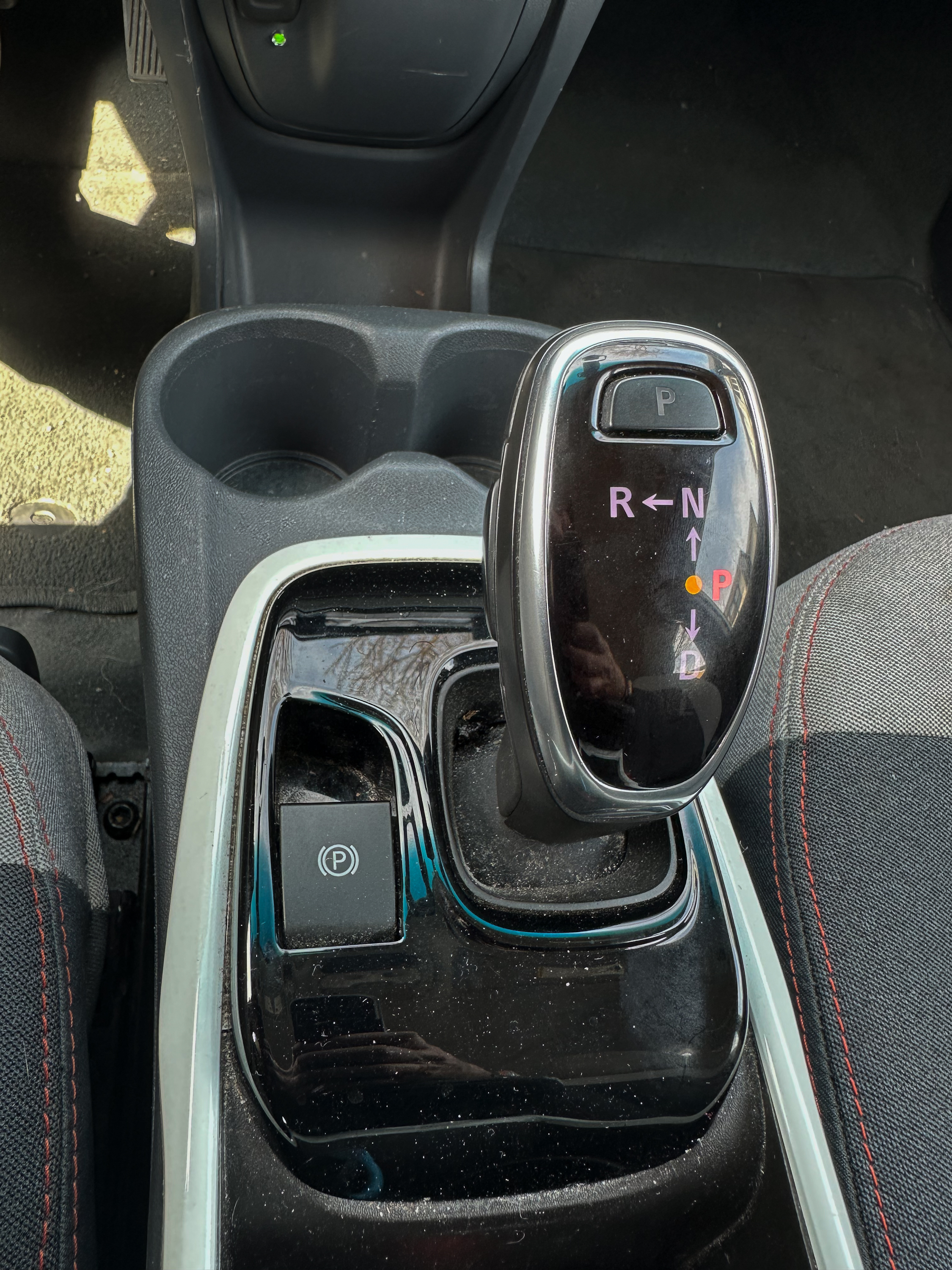
Chevy Equinox
| Year | 2025 |
| Fuel type | Electric |
| Fuel Door Opening | Door located on front driver's side of car, push on door to open |
| Charge Port Type | J1227 for Level 2, CCS for DC Fast Charge |
| Max Range | 319 miles |
| Key | Keyless - press brake to start |
| Body Type | SUV |
| Backup Camera | Yes |
Chevy Equinox Ignition
To start the Chevy Equinox, just press the brake pedal while on an active trip. There is no physical ignition button in the vehicle.
The car will automatically turn off when you have stopped the vehicle, opened the driver's side door, and disconnected your seatbelt. To manually turn the car off, use the button on the screen.
The button with a car and a clock symbol to the right of the Off button will toggle on an option to keep the car running with the doors open. If you accidentally press this, you can disengage this feature using the Off button on the screen. Once you've opened the door, make sure you don't press the brake pedal on the way out, as that will restart the car!
Chevy Equinox Gear Shift
To shift gears, use the lever on the right of the steering wheel. You will need to have your seat belt buckled in order to shift into gear.
- Drive: pull towards you and down.
- Reverse: pull towards you and up.
- Neutral: Pull towards you.
- Park: press the silver button on the end of the lever.
Chevy Equinox Door Handles
The door handles of the Chevy Equinox lay flat to the car and will pop up when the car is unlocked and go down when the car is locked. Starting or resuming your trip will pop the handles up, and pausing or ending your trip will push them back down. The driver's side door will be the only door unlocked when starting your trip, even though all the handles pop up.
If the car is sitting unlocked for a few minutes, the handles will pop back down. Pressing the driver's door handle will pop them all back up as long as the car is still unlocked.
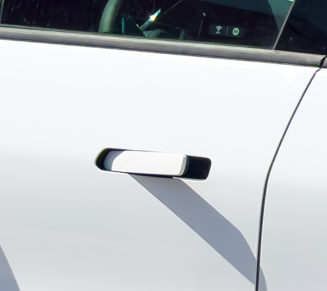
Chevy Equinox Parking Brake and Controls
The controls by the driver's side left knee have the following buttons, from left to right:
- Parking Brake: engages the parking brake
- Lane Keep Assist: safety feature to automatically correct lane drifting. See details in Lane Keep Assist.
- Auto Hold: allows the car to hold at a full stop without the brake pressed
- Dashboard Lights Adjuster: sets brightness of dashboard lights and screens
Chevy Equinox Windshield Wipers
The windshield wiper controls are barrel switches embedded in the turn signal stalk. The rear wipers are on the right and the front wipers are on the left.
The silver button on the end of the stalk will activate the front wipers and washer fluid when pressed all the way down. To activate only front wipers, press the same button halfway down. To activate back window washer fluid, rotate the right barrel switch to either end position and hold. When released, it will go back to it's previous position and stop fluid flow.
Chevy Equinox Safety Features
Lane Keep Assist
Lane Keep Assist uses a brief steering wheel turn to prevent a potential lane departure when it detects you are unintentionally drifting out of your lane lines. System alerts do not occur if you’re using your turn signal, or if it detects you may be intentionally leaving your lane.
It’s important to remember that even though this feature provides brief steering nudges, it doesn’t continuously steer your vehicle.
Crash Avoidance Braking and Alerts
The Chevy Equinox is equipped with Crash Avoidance Alerts that will either be a beeping noise or a vibrating seat to help you detect and identify the direction of potential crashes. The vehicle will also engage the brakes automatically if a collision or hazard is detected.
To switch alert types, go to Settings > Vehicle > Collision / Detection Systems > Alert Type.
Safety or driver assistance features are no substitute for the driver’s responsibility to operate the vehicle in a safe manner. The driver should remain attentive to traffic, surroundings and road conditions at all times. Visibility, weather and road conditions may affect feature performance.
Alerts and automatic braking may include:
- Front Pedestrian Braking and Alert
- Intersection Collision Braking and Alert
- Rear Cross Traffic Braking and Alert
- Rear Park Assist Braking and Alert
Chevy Equinox Infotainment System
To access the Infotainment System, press the flat physical button on the top left of the screen. Please only explore the Infotainment system apps and options while the vehicle is safely parked.
To return the screen to the simple time and date mode, press and hold the button on the top left of the screen.
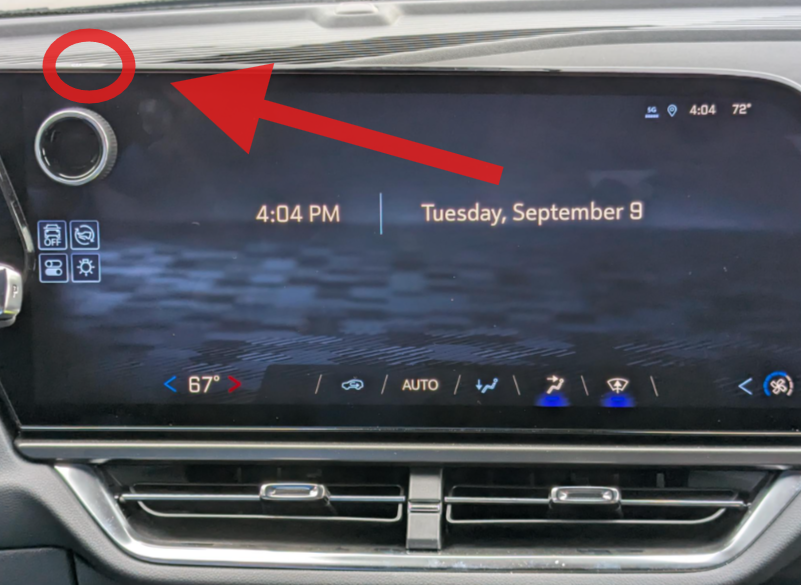
Chevy Equinox Regenerative Braking
Regenerative braking (regen) means the electric motor acts as a generator when you lift off the pedal or brake, sending power back into the battery. This happens automatically on all braking, but you can maximize the energy that is collected by driving efficiently or engaging gears that force efficient driving.
In the Chevy Equinox, you can maximize regen by using One-Pedal Drive mode. To engage, press the icon on the bottom left corner of the screen that has an icon of a looping arrow around a foot pressing on a pedal. You can adjust the strength of the One-Pedal Drive mode in the sub menu, which we strongly recommend. The Equinox's One-Pedal Drive can be aggressive, so be sure to drive with care and adjust to the drive mode in a safe area before relying on this feature.

Honda Civic
| Year | 2012, 2013, and 2014 |
| Fuel type | Gas |
| Fuel Door Opening | Release lever on driver's side floor |
| Gas Tank Capacity | 12.4 gal |
| Key | Keyed vehicle, key is in glove box |
| Body Type | Sedan |
| Backup Camera | No |
Honda Civic Parking Brake
Brake on:
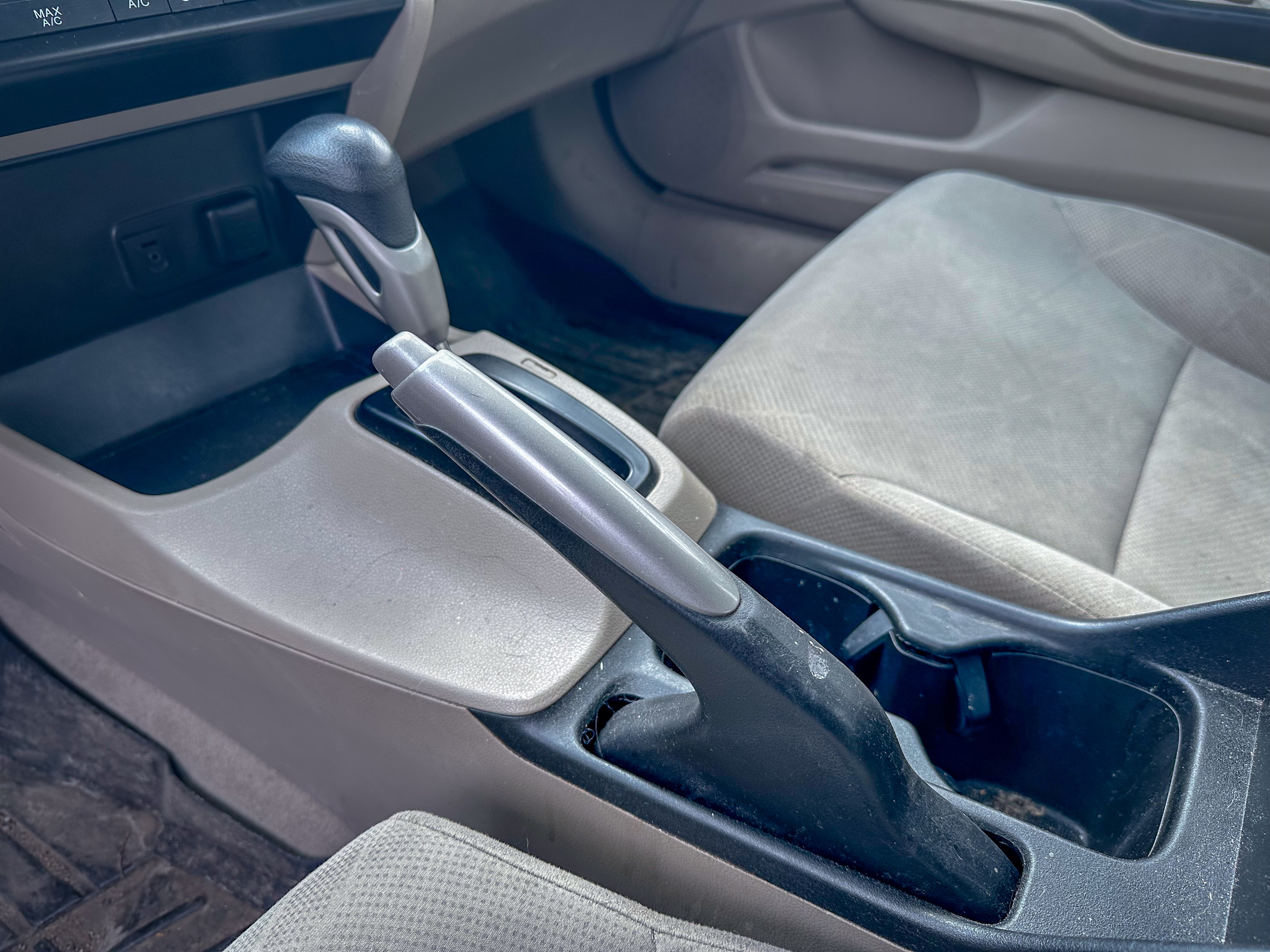
Brake off:

Honda Fit
| Year | 2012 and 2013 |
| Fuel type | Gas |
| Fuel Door Opening | Push cap to open |
| Gas Tank Capacity | 10.6 gal |
| Key | Keyed vehicle, key is in glove box |
| Body Type | Hatchback |
| Backup Camera | No |
Honda Fit Parking Brake
Brake on:
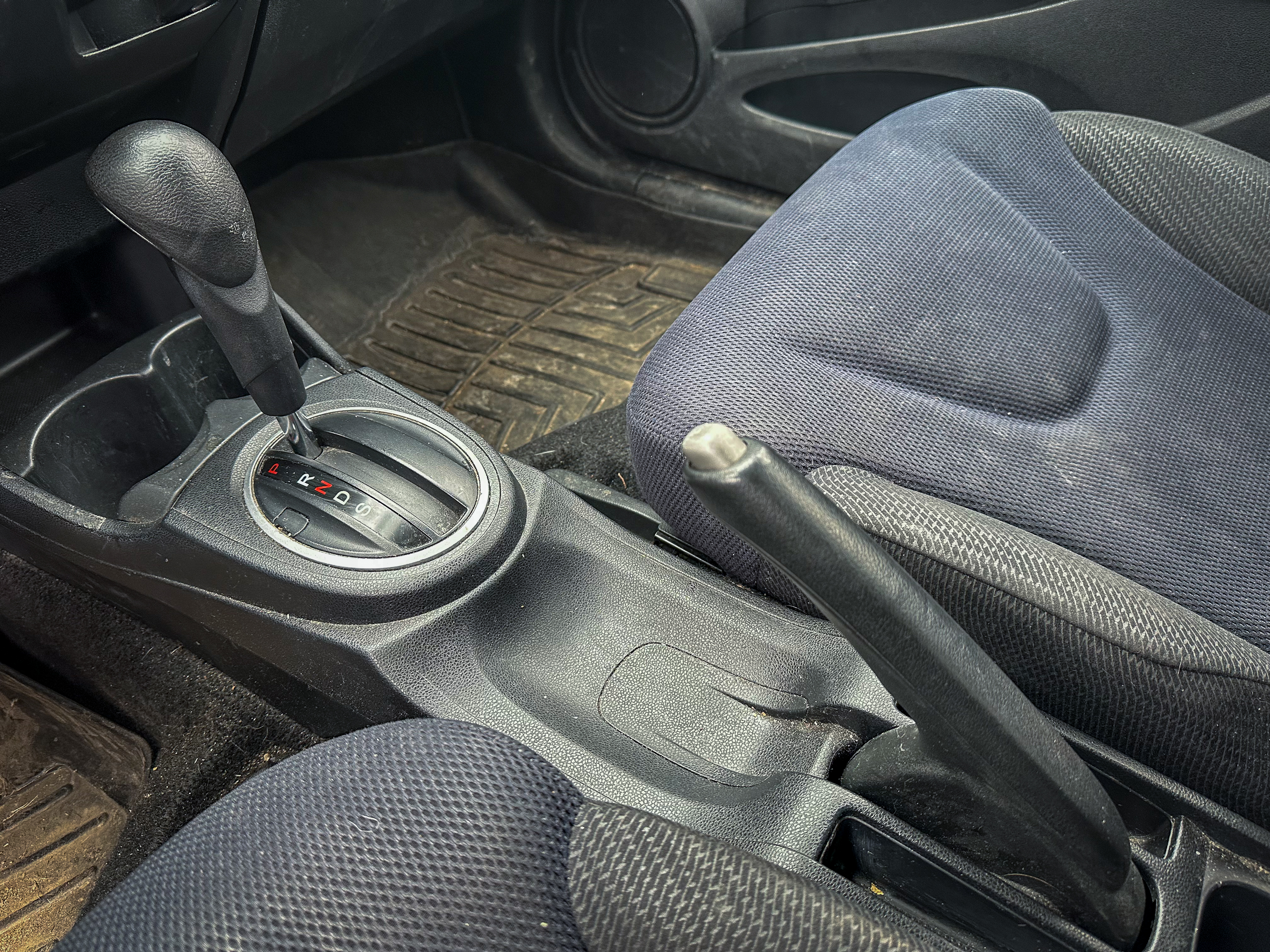
Brake off:
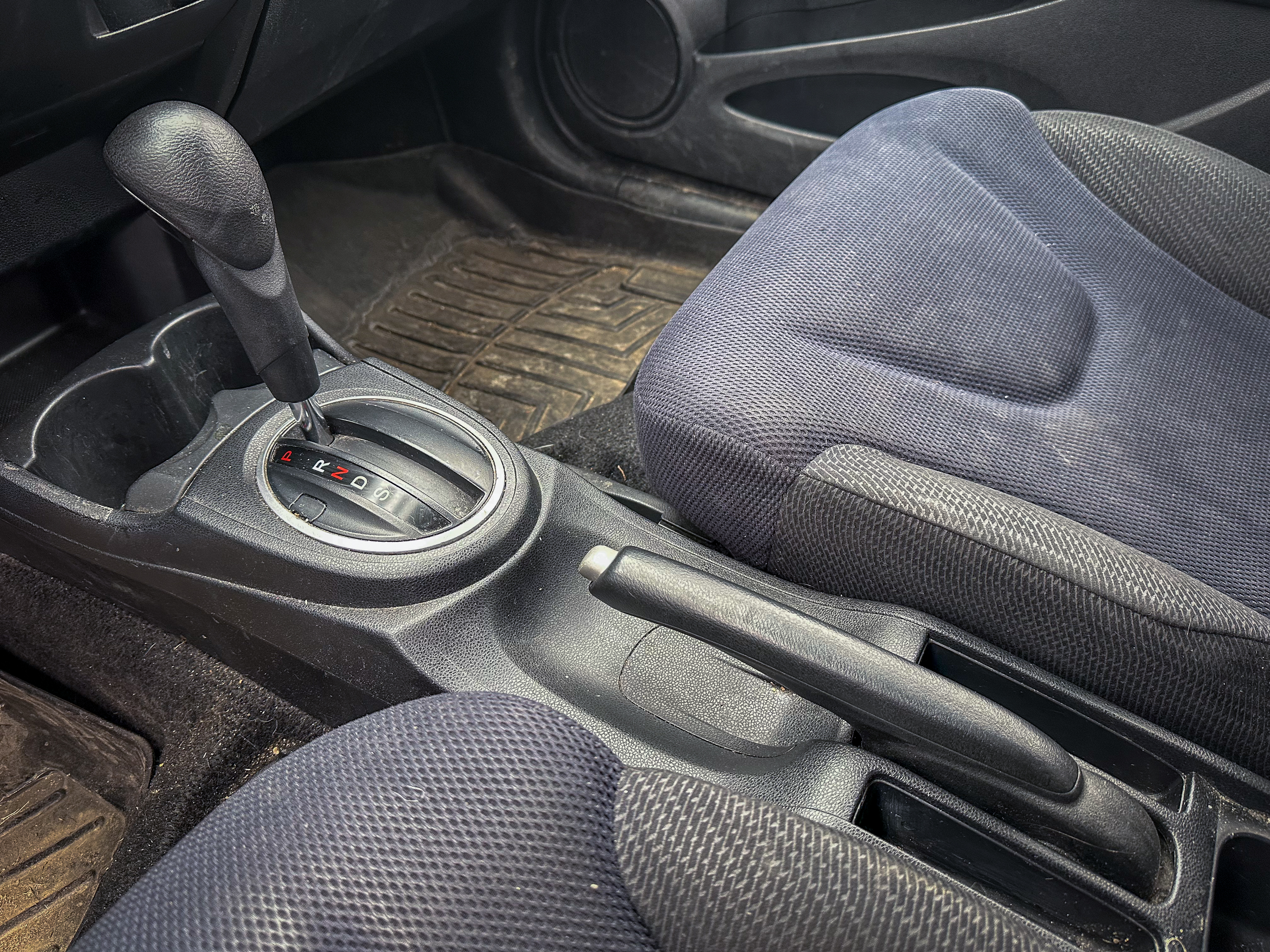
Hyundai Ioniq
| Year | 2021 and 2022 |
| Fuel type | Hybrid |
| Fuel Door Opening | Push cap to open |
| Gas Tank Capacity | 11.9 gal |
| Key | Keyless |
| Body Type | Hatchback |
| Backup Camera | Yes |
Hyundai Ioniq Parking Brake
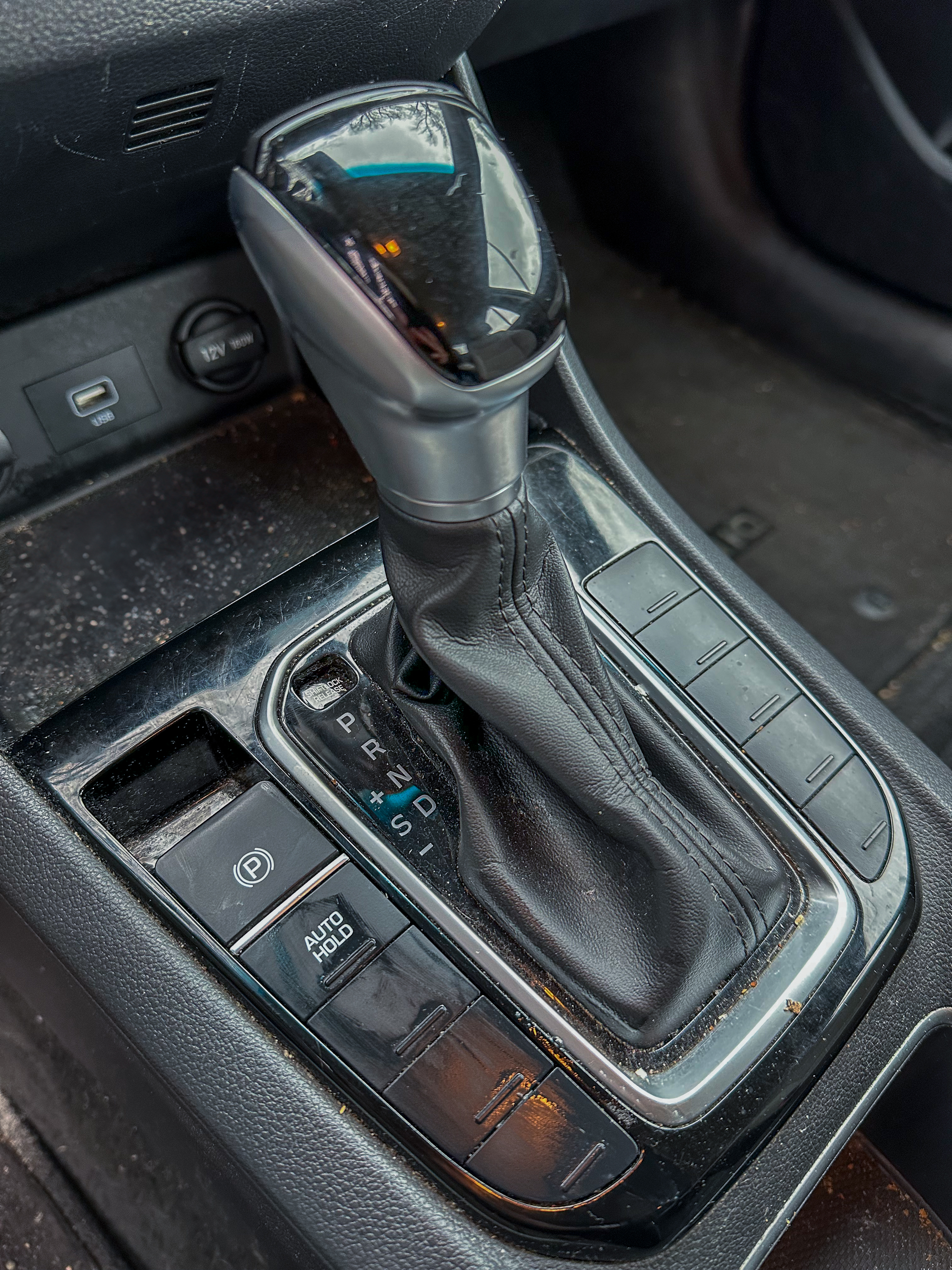
Hyundai Ioniq Self Jump Start
The Ioniq's 12V starter battery has a Self Jump Start option. If the battery is dead, press the '12V Batt Reset' button next to the gas tank release to use the lithium-ion hybrid battery for a jump.

Hyundai Kona
| Year | 2023 |
| Fuel type | Gas |
| Gas Tank Capacity | 12.4 gal |
| Key | Keyed vehicle, key is in glove box |
| Body Type | Hatchback |
| Backup Camera | Yes |
Hyundai Kona Fuel Door
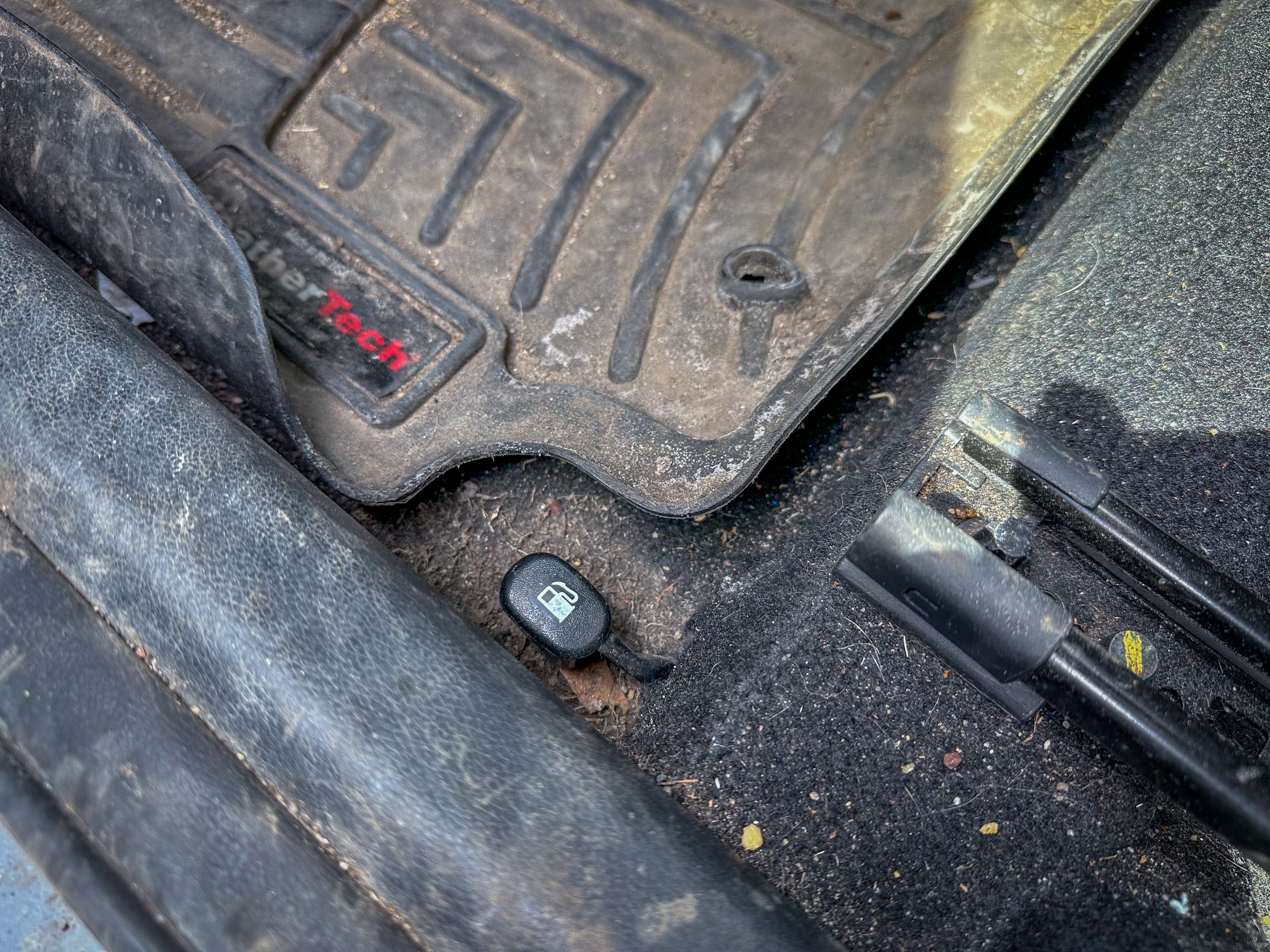
Hyundai Kona Parking Brake
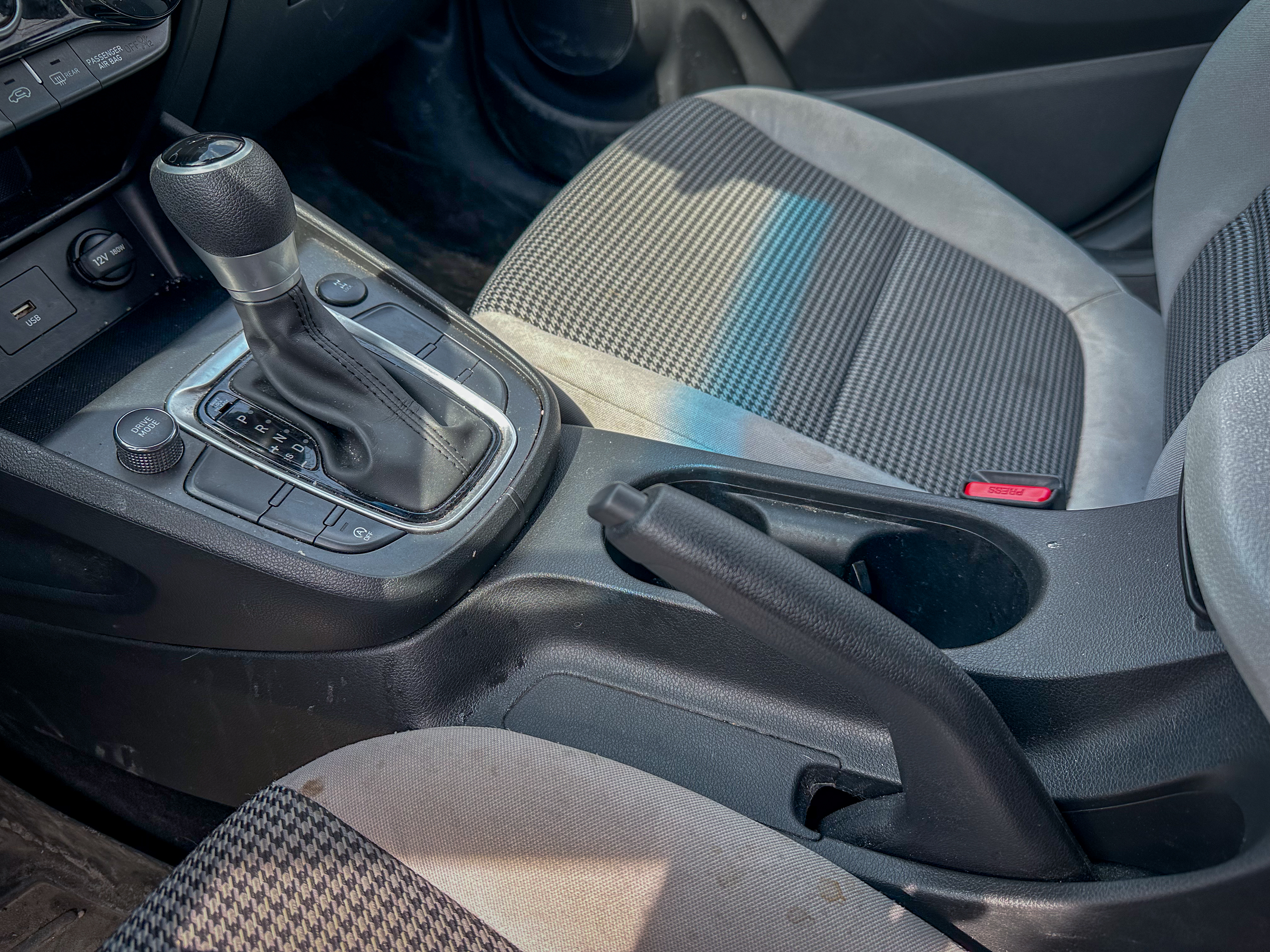
Hyundai Santa Cruz
| Year | 2023 |
| Fuel type | Gas |
| Fuel Door Opening | Push cap to open |
| Gas Tank Capacity | 17.7 gal |
| Key | Keyless |
| Body Type | Crew Cab with compact truck bed |
Hyundai Santa Cruz Parking Brake
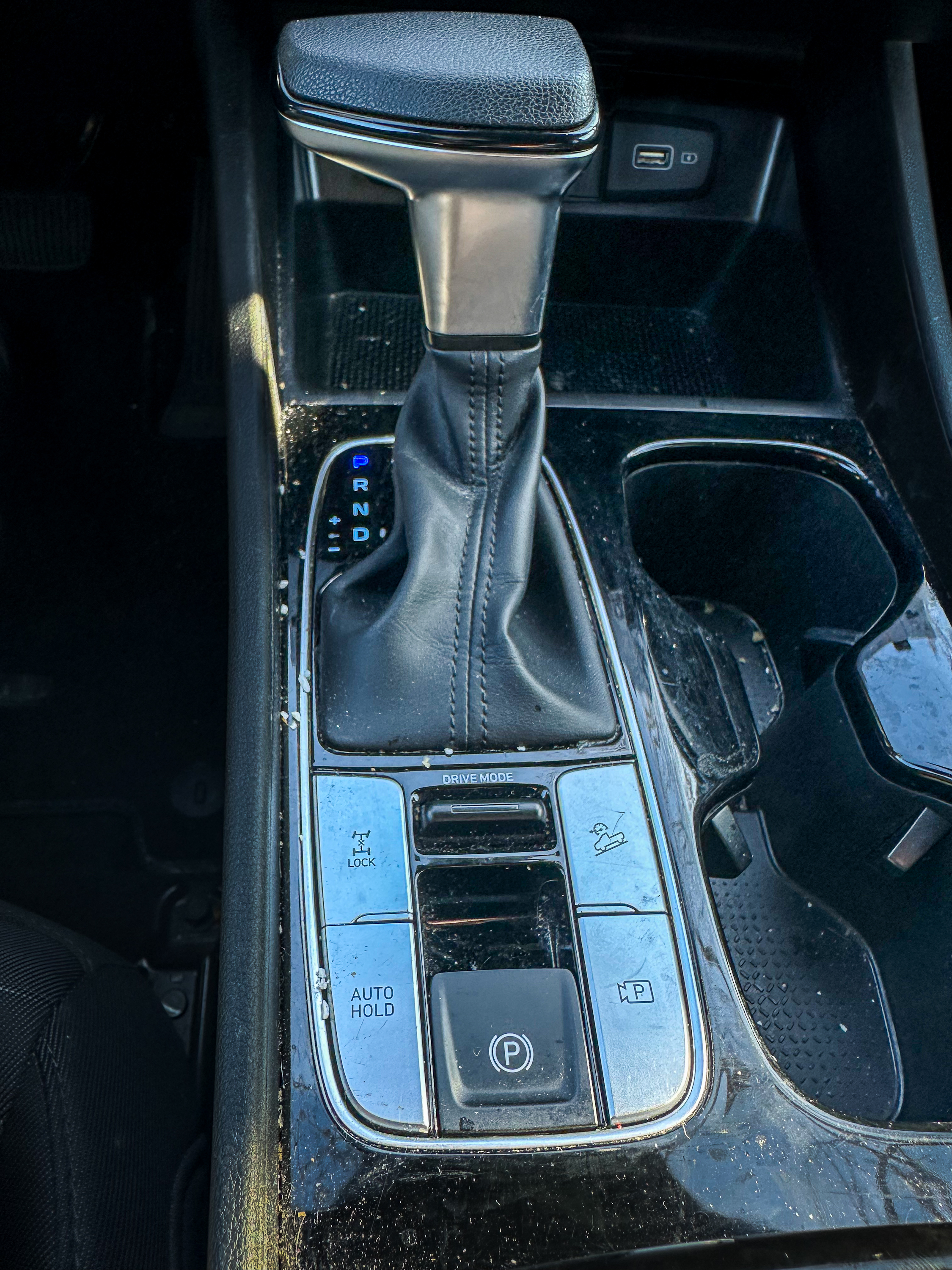
Kia Soul
| Year | 2018 and 2019 |
| Fuel type | Gas |
| Fuel Door Opening | Release lever on driver's side floor |
| Gas Tank Capacity | 14.3 gal |
| Key | Switchblade key located in glovebox |
| Body Type | Hatchback |
| Backup Camera | Yes |
Kia Soul Parking Brake
Brake on:
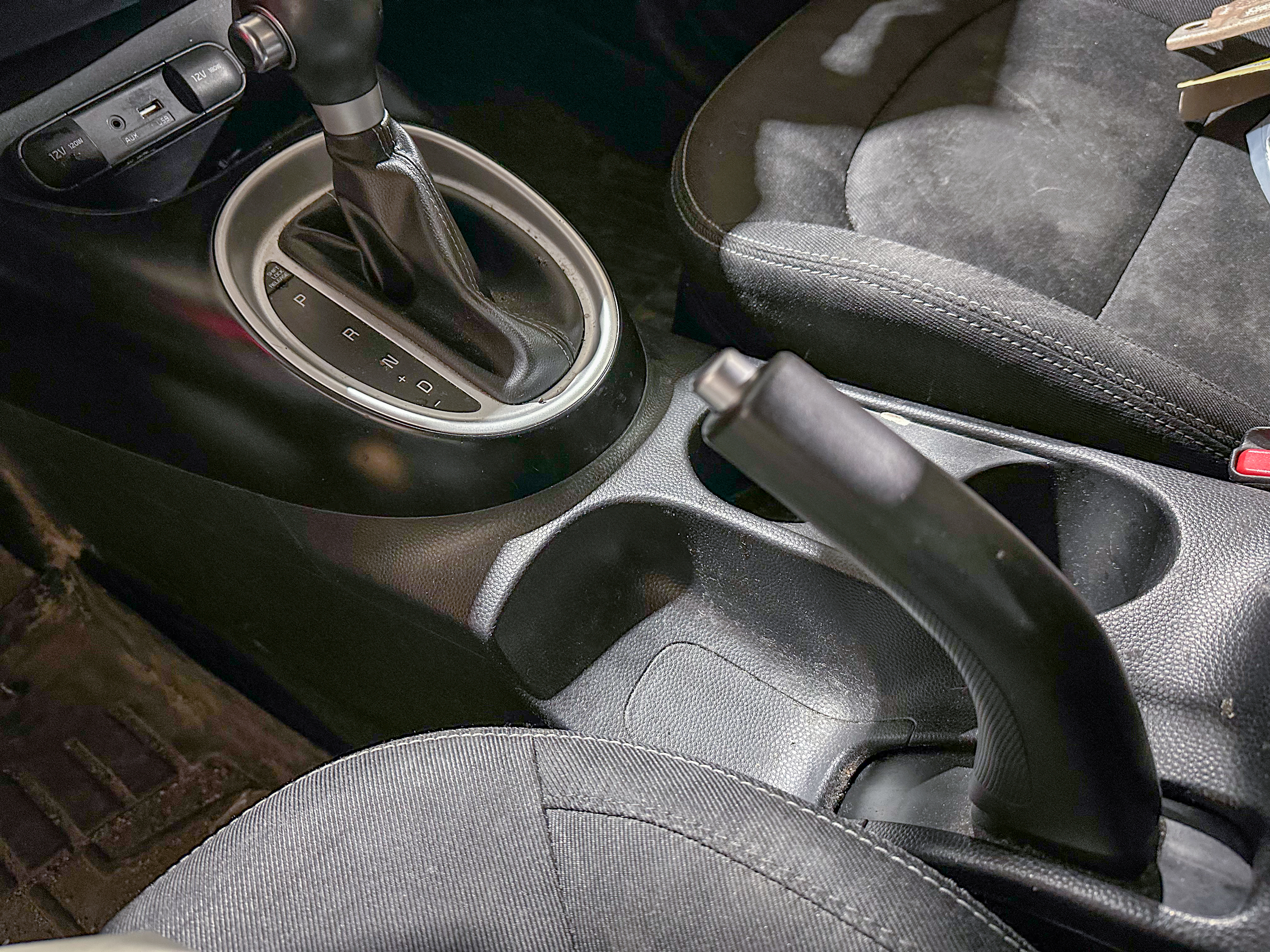
Brake off:
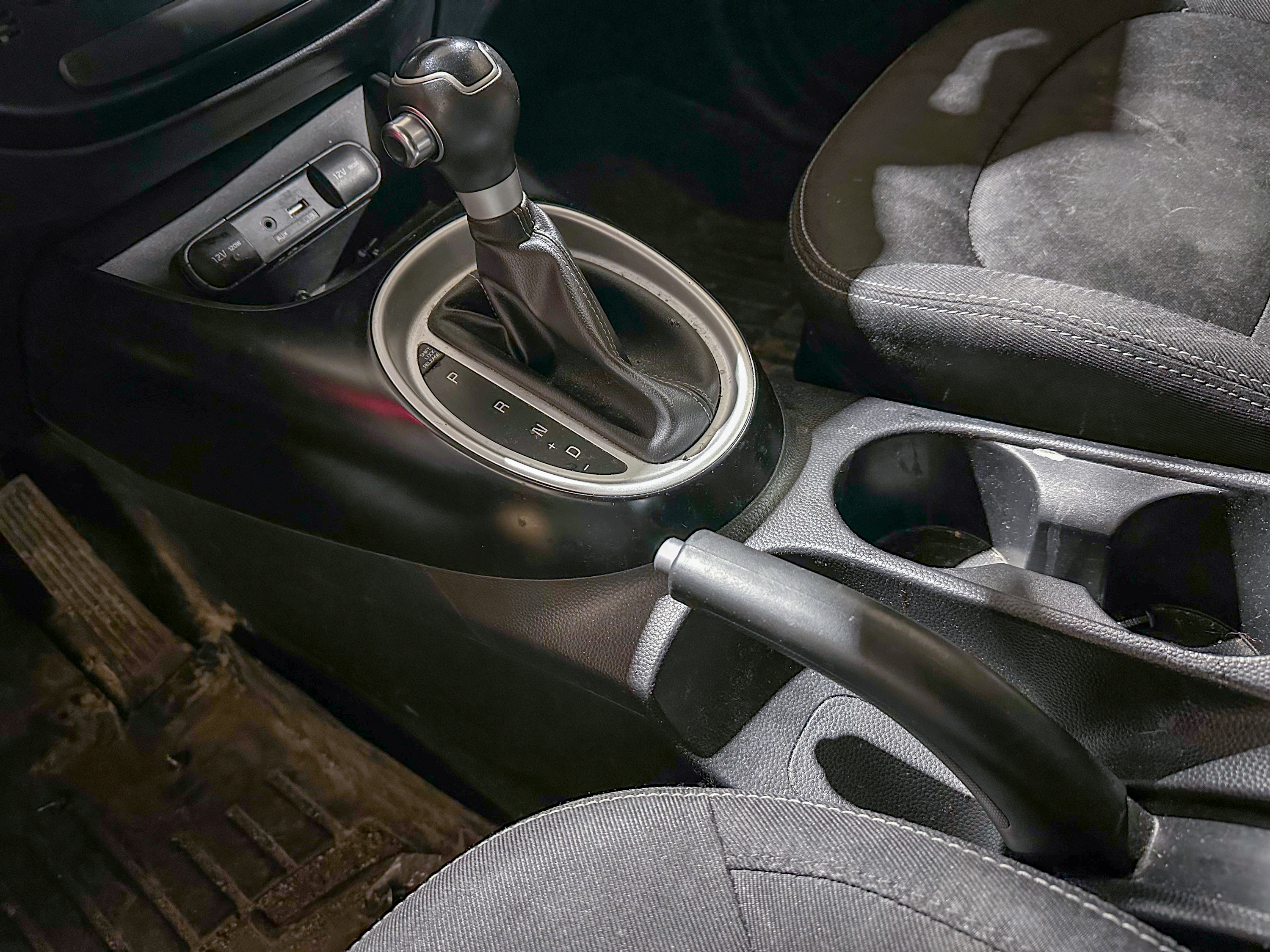
Kia Soul Switchblade Key
Press button to release switchblade key:
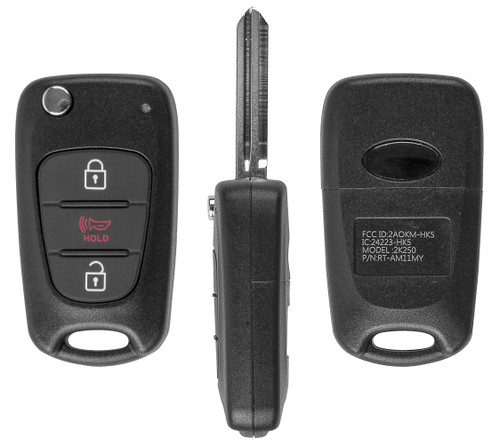
Mitsubishi Outlander Sport
| Year | 2018, 2020, 2021, 2022, and 2023 |
| Fuel type | Gas |
| Fuel Door Opening | Release lever on driver's side floor |
| Gas Tank Capacity | 15.8 gal |
| Key | Keyed vehicle, key is in glove box |
| Body Type | SUV |
| Backup Camera | Yes |
Mitsubishi Outlander Sport Parking Brake
Brake on:
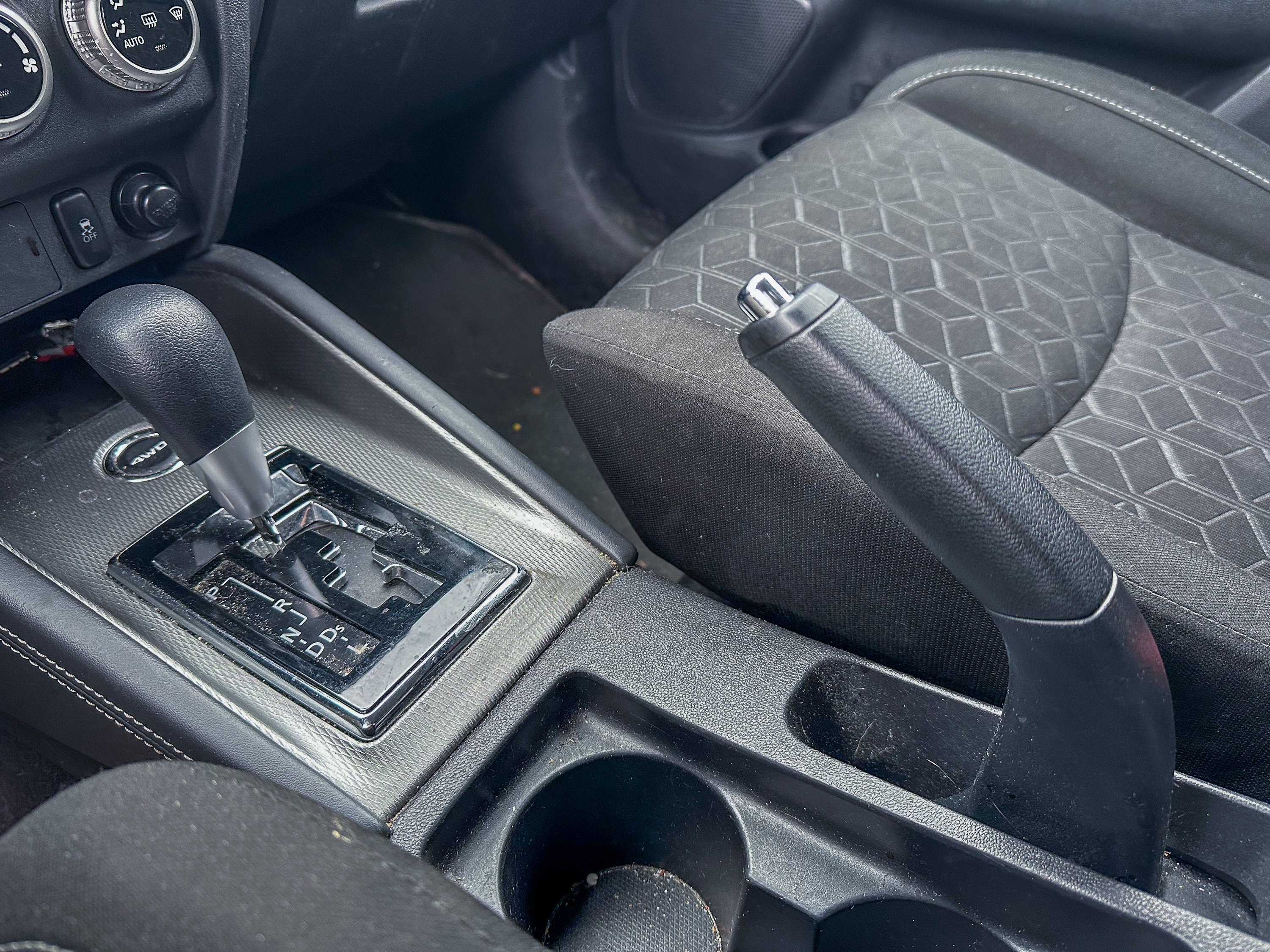
Brake off:
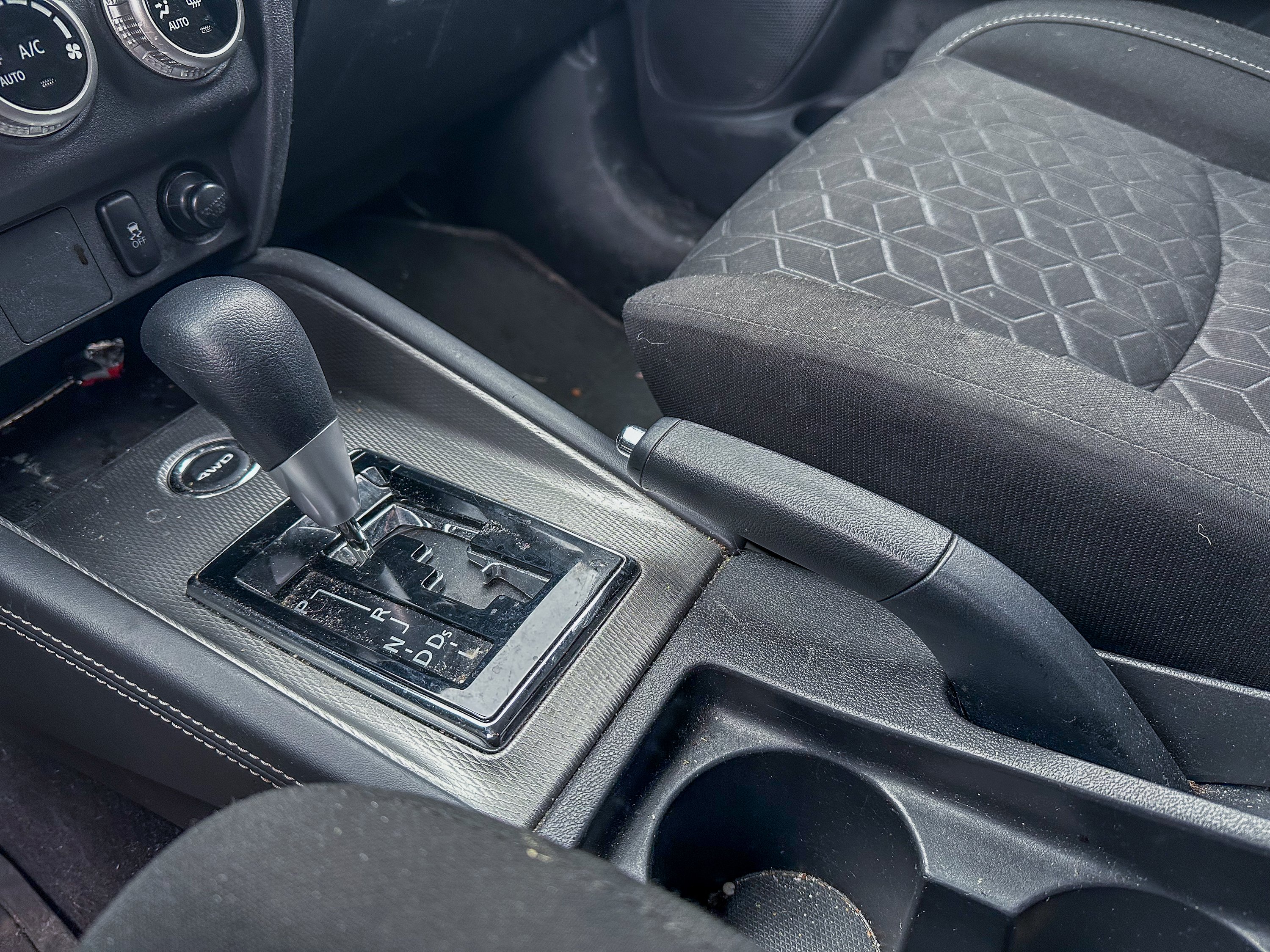
Nissan Leaf
| Year | 2023 |
| Fuel type | Electric |
| Fuel Door Opening | Door is on front of car, push release button to left of steering wheel |
| Charge Port Type | J1227 for Level 2, CHAdeMO for DC Fast Charge |
| Max Range | 149 miles, 116 miles in winter |
| Key | Keyless |
| Body Type | Hatchback |
| Backup Camera | Yes |
Nissan Leaf Regenerative Braking
Regenerative braking (regen) means the electric motor acts as a generator when you lift off the pedal or brake, sending power back into the battery. This happens automatically on all braking, but you can maximize the energy that is collected by driving efficiently or engaging gears that force efficient driving.
In the Nissan Leaf, the Eco button will help you drive more efficiently, and you can maximize regen by using One-Pedal Drive mode (B gear) and the E-Pedal to slow down without using the friction brakes.
See What's the Gear? info for more details.
Nissan Leaf Parking Brake
Press down on foot pedal parking brake to engage and release the brake.
Brake on:
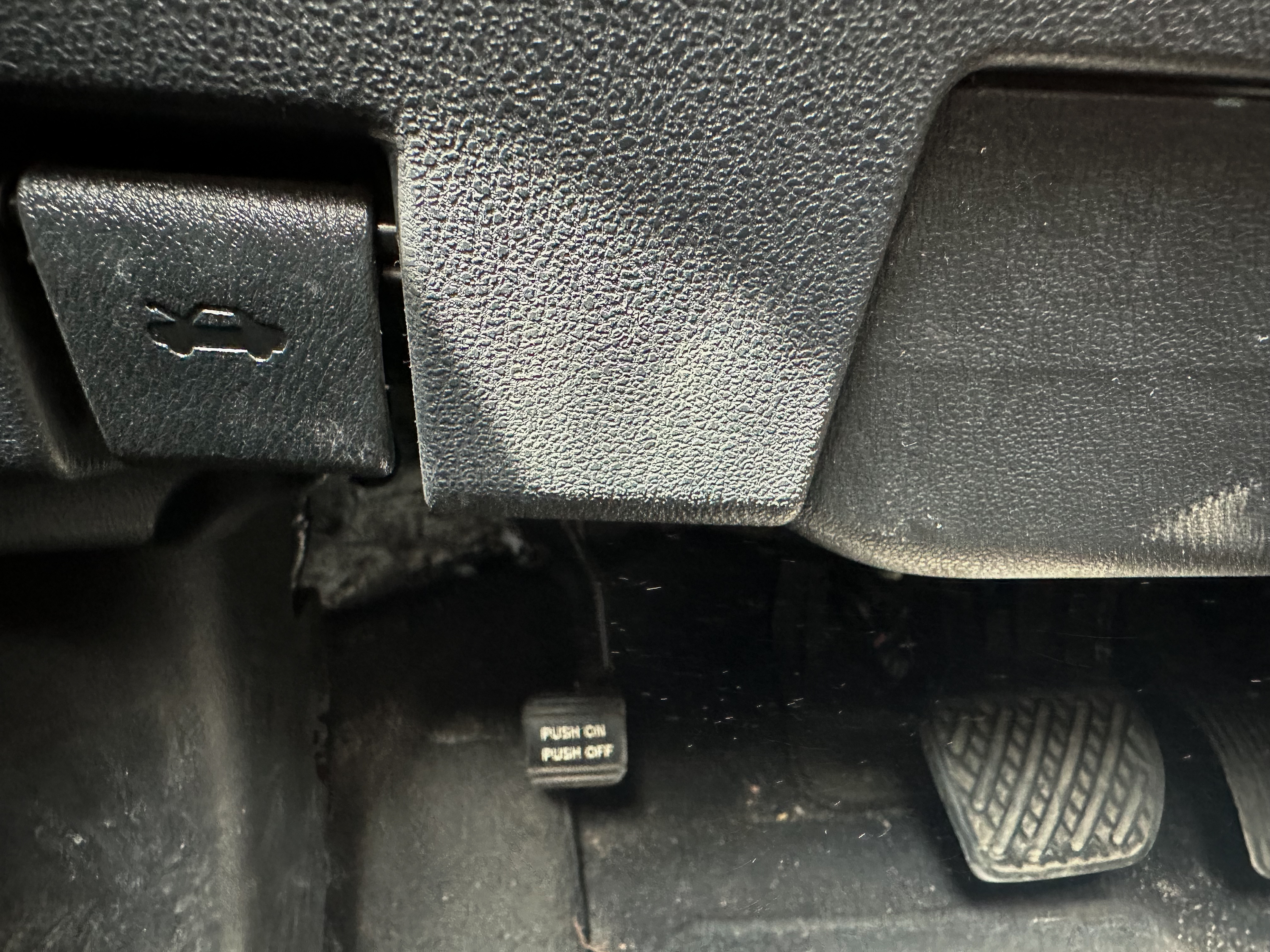
Brake off:
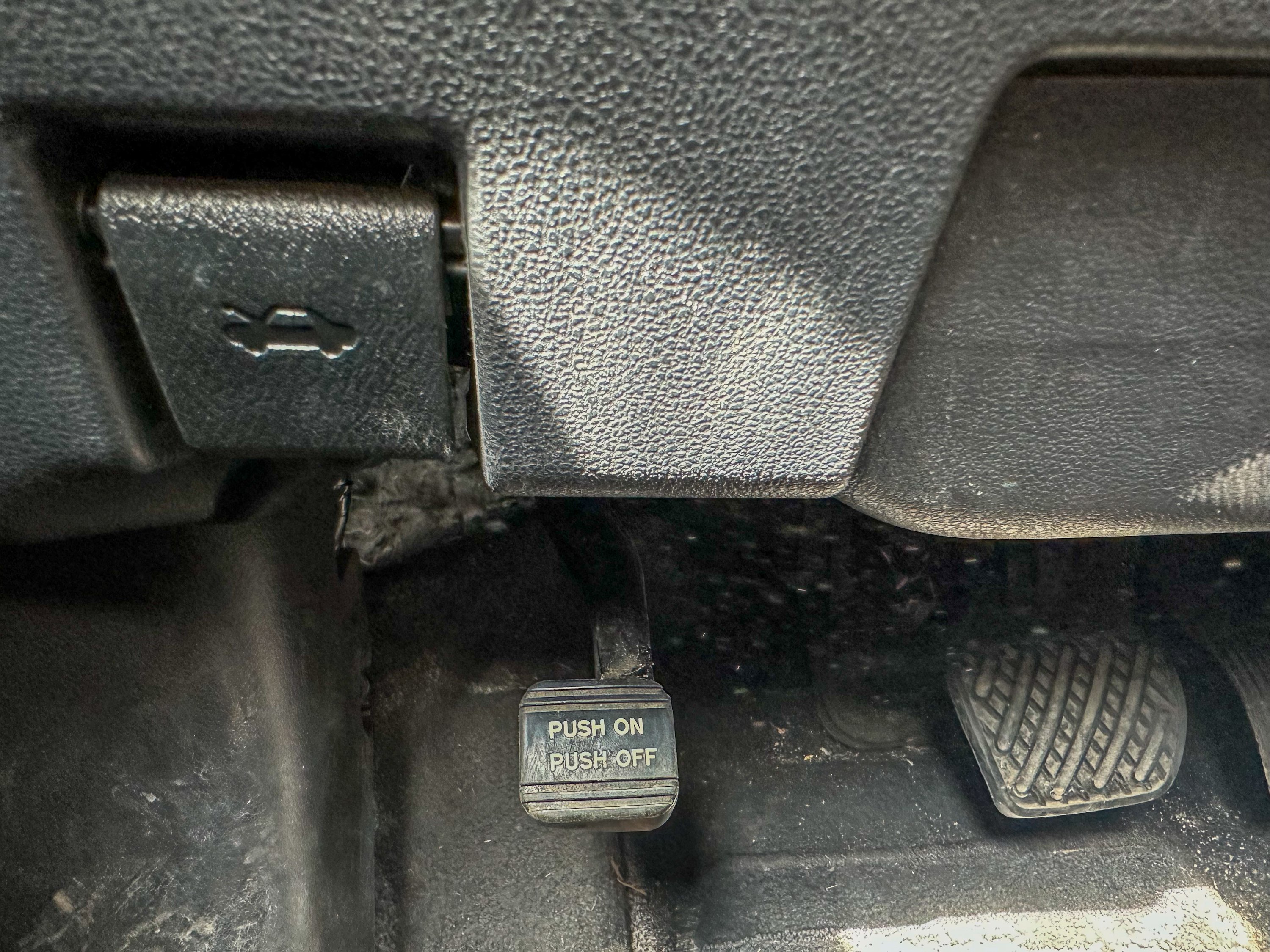
Nissan Leaf PLUS
| Year | 2022 |
| Fuel type | Electric |
| Fuel Door Opening | Door is on front of car, push release button to left of steering wheel |
| Charge Port Type | J1227 for Level 2, CHAdeMO for DC Fast Charge |
| Max Range | 226 miles, 180 miles in winter |
| Key | Keyless |
| Body Type | Hatchback |
| Backup Camera | Yes |
Nissan Leaf PLUS Regenerative Braking
Regenerative braking (regen) means the electric motor acts as a generator when you lift off the pedal or brake, sending power back into the battery. This happens automatically on all braking, but you can maximize the energy that is collected by driving efficiently or engaging gears that force efficient driving.
In the Nissan Leaf, the Eco button will help you drive more efficiently, and you can maximize regen by using One-Pedal Drive mode (B gear) and the E-Pedal to slow down without using the friction brakes.
See What's the Gear? info for more details.
Nissan Leaf PLUS Parking Brake
Press down on foot pedal parking brake to engage and release the brake.
Brake on:

Brake off:

Subaru Crosstrek
| Year | 2019 |
| Fuel type | Gas |
| Fuel Door Opening | Release lever on driver's side floor |
| Gas Tank Capacity | 16.6 gal |
| Key | Keyed vehicle, key is in glove box |
| Body Type | Hatchback |
| Backup Camera | Yes |
Subaru Crosstrek Parking Brake
Brake on:

Brake off:
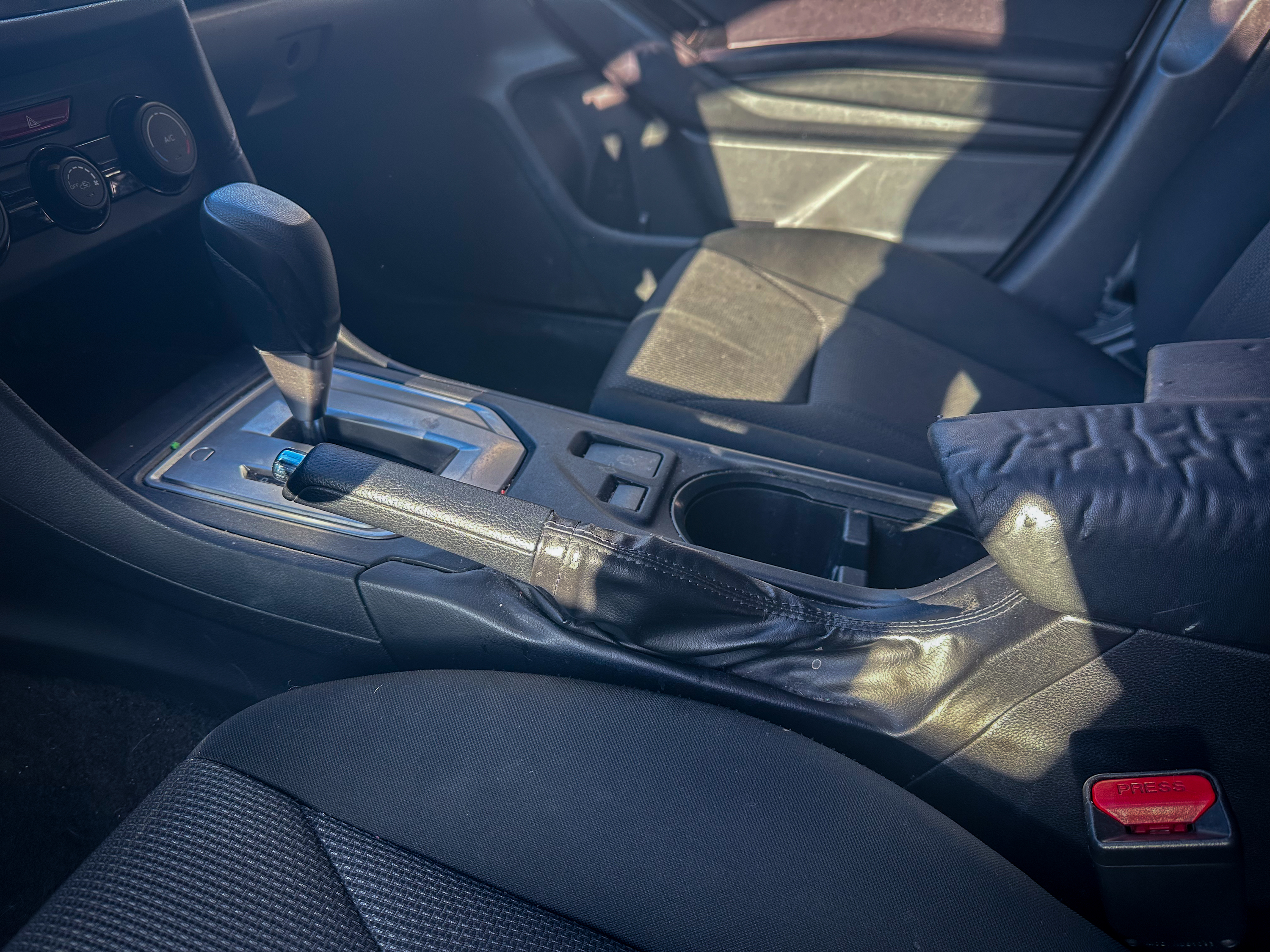
Subaru Impreza Hatchback
| Year | 2018 |
| Fuel type | Gas |
| Fuel Door Opening | Release lever on driver's side floor |
| Gas Tank Capacity | 13.2 gal |
| Key | Keyed vehicle, key is in glove box |
| Body Type | Hatchback |
| Backup Camera | Yes |
Subaru Impreza Hatchback Parking Brake
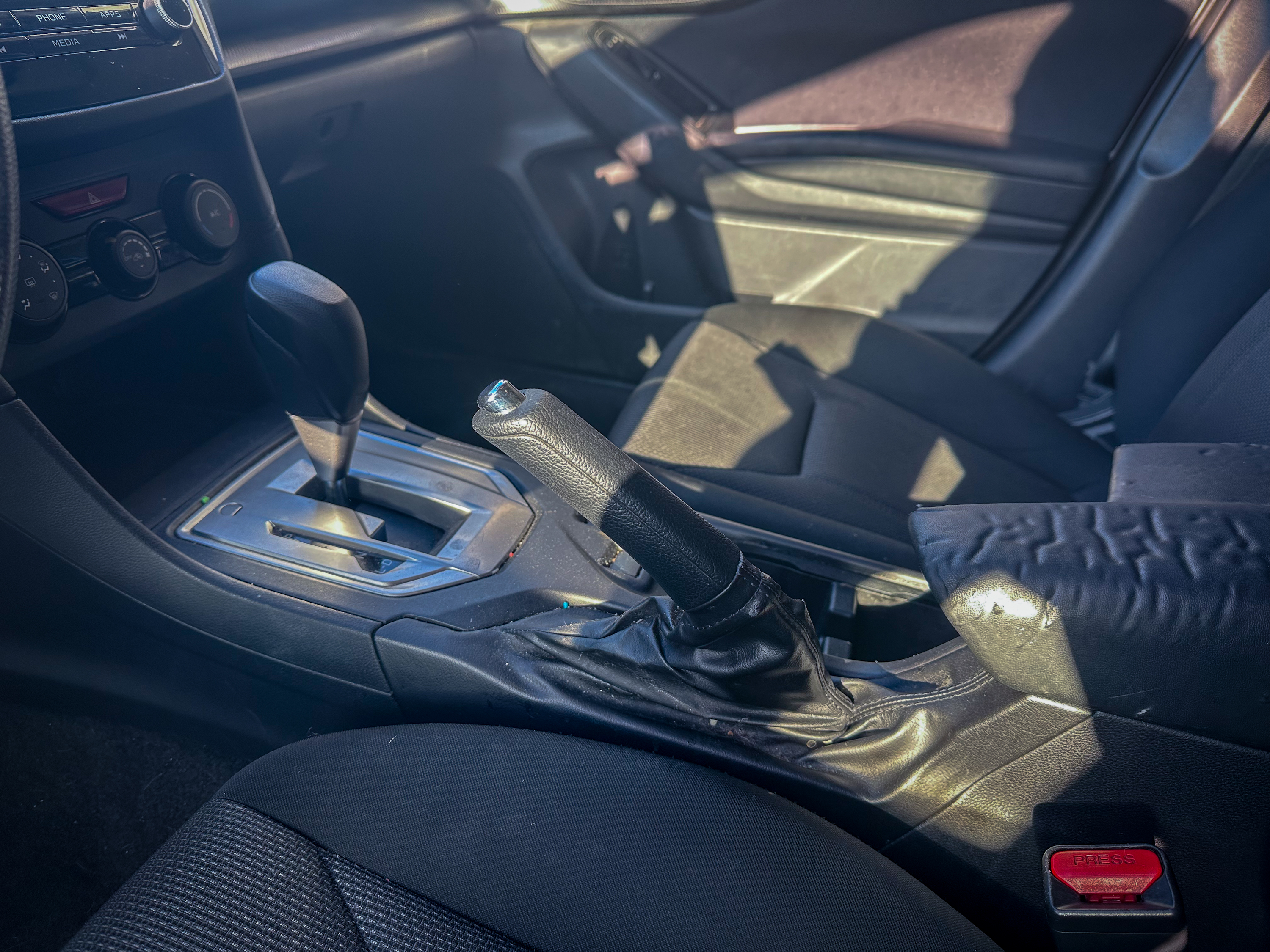
Subaru Impreza Sedan
| Year | 2017 |
| Fuel type | Gas |
| Fuel Door Opening | Release lever on driver's side floor |
| Gas Tank Capacity | 13.2 gal |
| Key | Keyed vehicle, key is in glove box |
| Body Type | Sedan |
| Backup Camera | Yes |
Subaru Impreza Sedan Parking Brake

Toyota Corolla
| Year | 2024 & 2025 |
| Fuel type | Gas & Hybrid |
| Fuel Door Opening | Release lever on driver's side floor |
| Gas Tank Capacity | 13.2 gal |
| Key | Keyless |
| Body Type | Sedan |
| Backup Camera | Yes |
Toyota Corolla Parking Brake
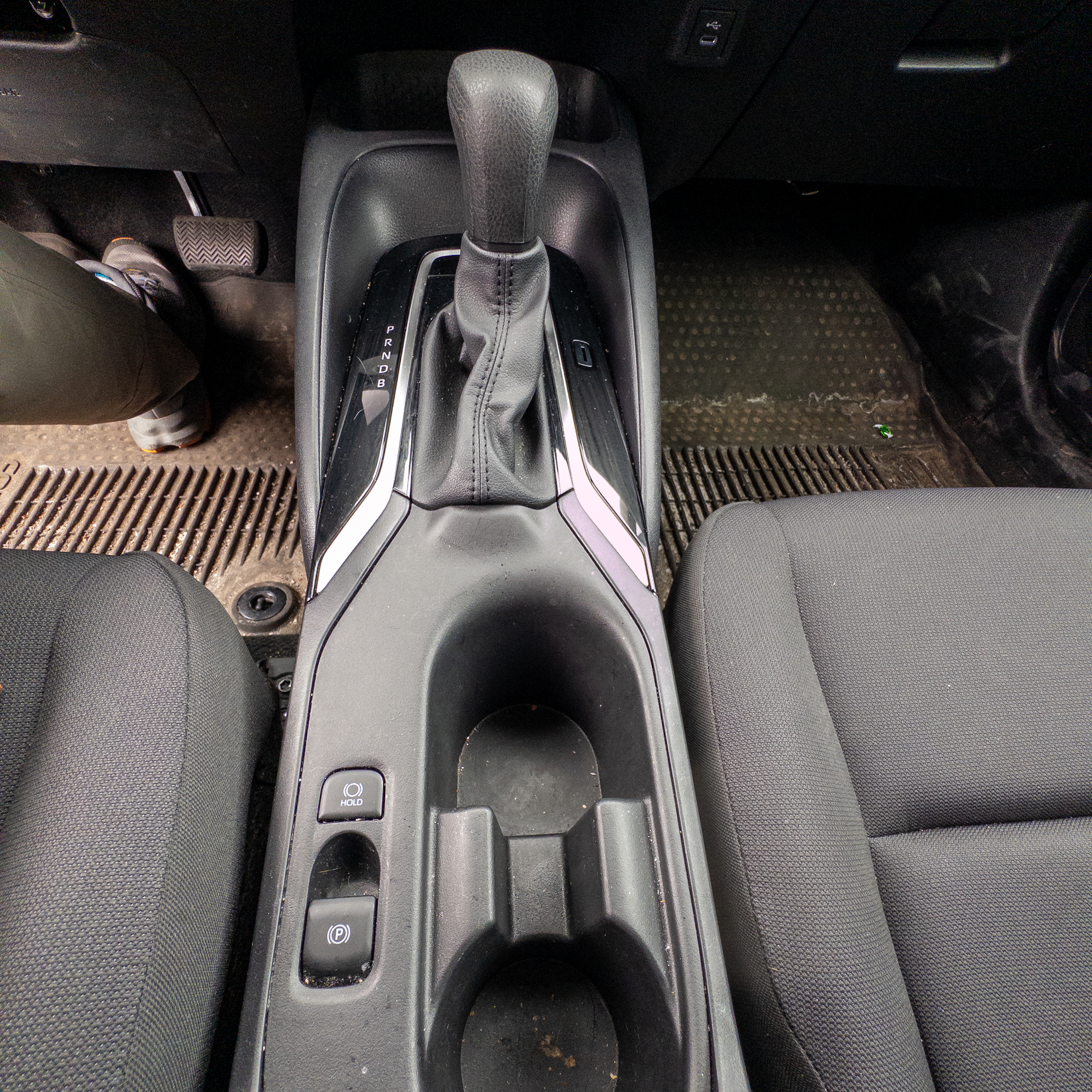
Toyota Prius
| Year | 2012 and 2013 |
| Fuel type | Hybrid |
| Fuel Door Opening | Release lever on driver's side floor |
| Gas Tank Capacity | 10.5 gal |
| Key | Push button start, key fob in glovebox |
| Body Type | Hatchback |
| Backup Camera | No |
Toyota Prius Parking Brake
If the car will not stop beeping and has a light that says "brake" lit up, it is being driven with the Parking brake on. Driving with it on can damage the brake and affect the car's performance.
Press down on foot pedal parking brake to engage and release the brake. The parking brake pedal is to the left and higher up than the other pedals. It may say "Push On, Push Off" or have a "P" icon, or the lettering may be too worn to read. If hard to find, stepping out of the car may help. It’s often confused with the 'P' park button in the center console, which only puts the car in park and doesn’t disengage the brake.
Brake on:
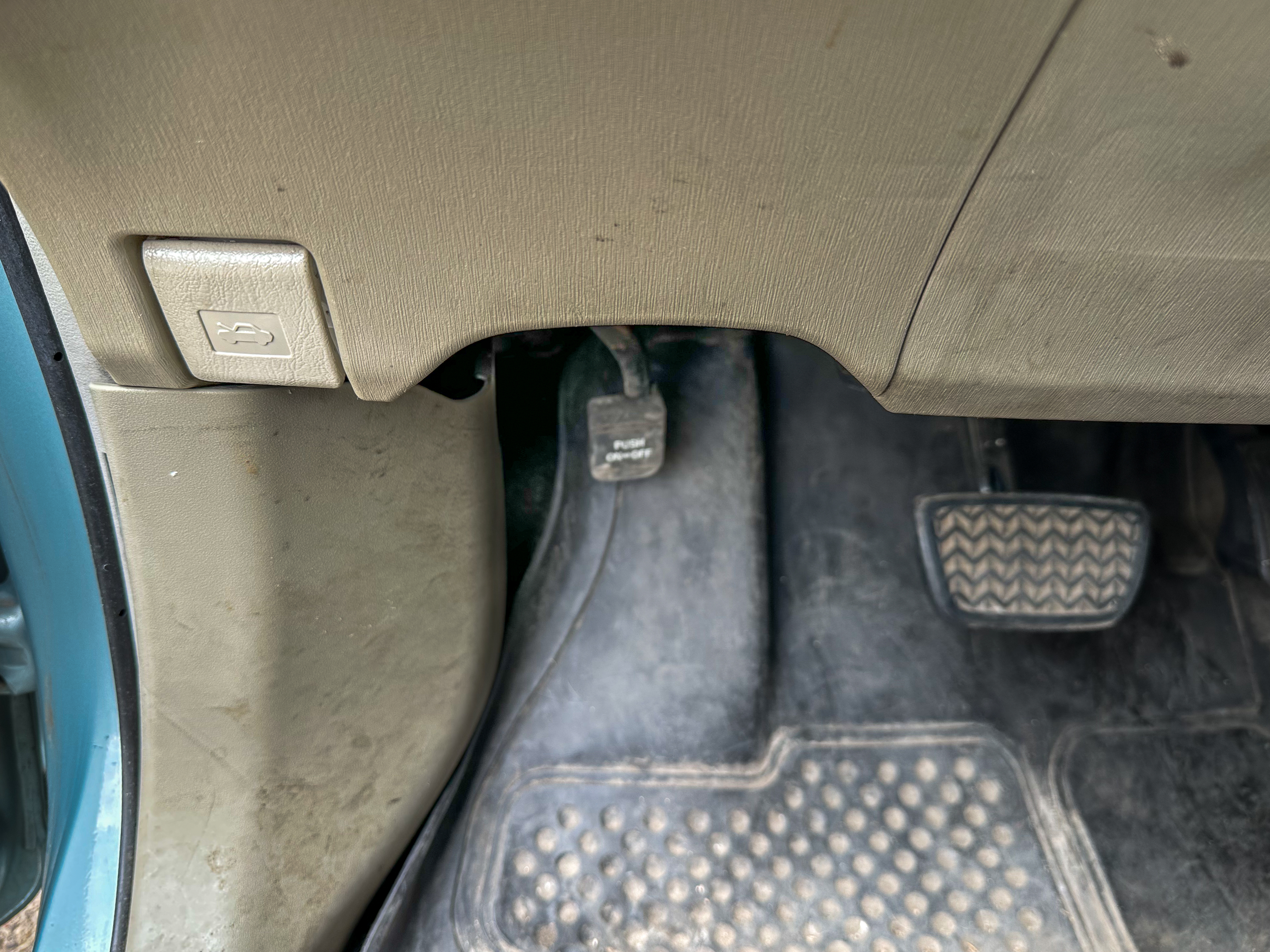
Brake off:
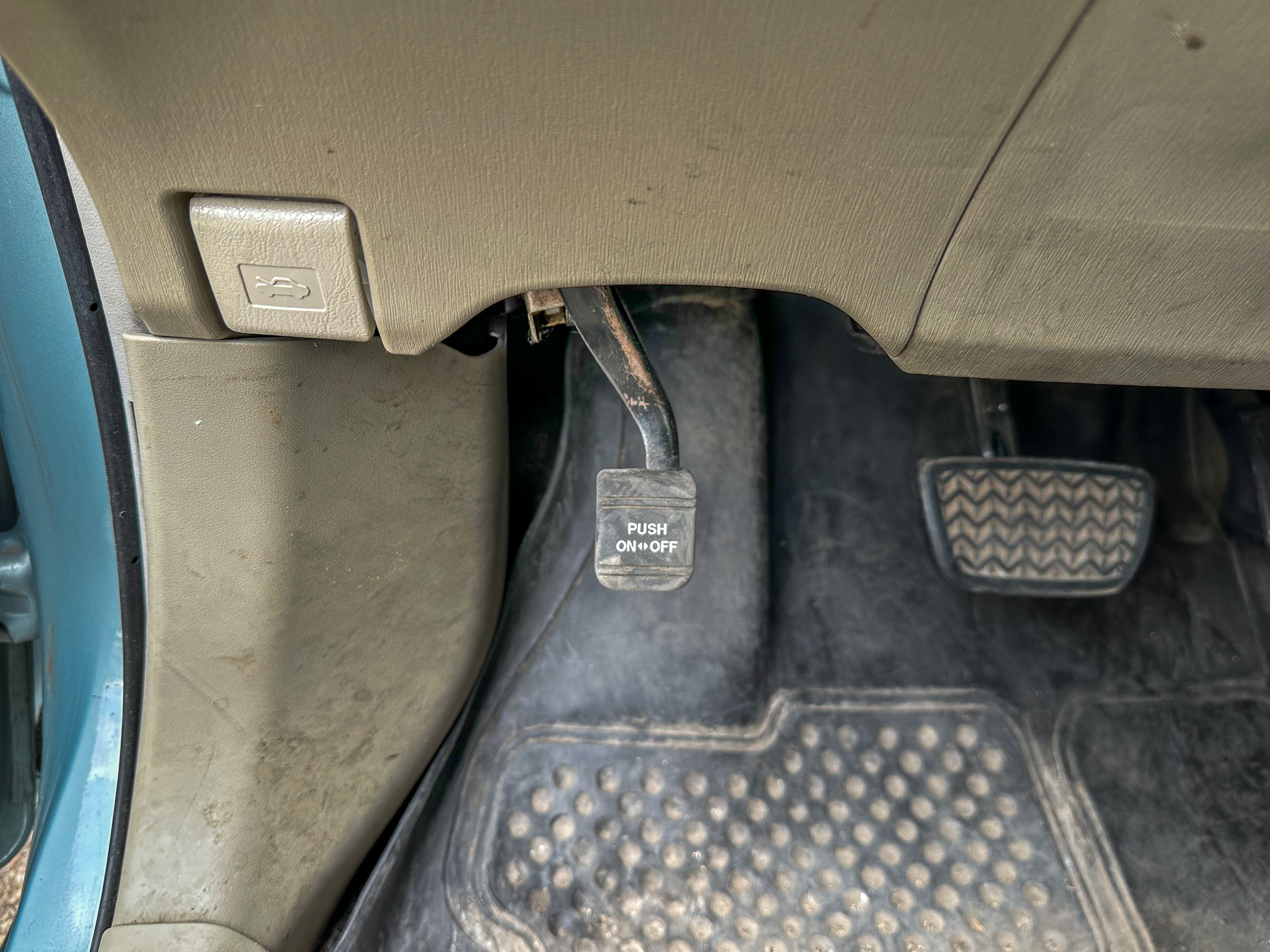
Toyota Prius: Starting the Vehicle
To start the car, hold down the brake pedal while pushing the power button. The car is very quiet upon starting and while idle so sometimes it is hard to tell by listening if the car has started. If you are unsure if the ignition is on, press the power button again to see if it turns off, then hold down the brake pedal while pushing the power button to turn it back on.
Regenerative Braking
Regenerative braking (regen) means the electric motor acts as a generator when you lift off the pedal or brake, sending power back into the battery. This happens automatically on all braking, but you can maximize the energy that is collected by driving efficiently or engaging gears that force efficient driving.
In the Chevy Bolt, you can maximize regen by using One-Pedal driving or the L Gear, as well as the regen paddle on the steering wheel to slow down without using the friction brakes.
In the Nissan Leaf, the Eco button will help you drive more efficiently, and you can maximize regen by using One-Pedal Drive mode (B gear) and the E-Pedal to slow down without using the friction brakes.
In the Chevy Equinox, you can maximize regen by using One-Pedal Drive mode.
What's the Gear?
Gears can be different in an electric vehicle. Use this guide to help you better understand your Evie. To know what gear you’re in, look at the dashboard. R=Reverse, D=Drive, N=Neutral, P=Park

This is your everyday forward driving gear. Push in the button on the left side of the shifter while pressing the brake pedal and shift down to engage.

To engage, follow the steps above, but shift down twice. In this gear, when you release the acceleration pedal, the car will engage in regenerative braking, putting energy back into the battery. If you aren’t slowing quick enough, use the brake pedal to stop.

The button in the center console to the left of the shifter is the emergency brake. Push down to engage, flick up to disengage. If the car senses movement in “Park”, it may automatically engage the e-brake. If this happens, it’ll automatically remove it when you put the car in “D” or “L”. Don’t drive if this is showing on the top-right corner of the dashboard.

This gear goes forward and increases regenerative braking on your trip. Regenerative braking converts energy from the cars motion back into the battery. To engage, press the brake pedal and pull the shift knob into the B gear when the car is in Drive.

The E-pedal is a switch unique to the Leaf that activates full braking when you lift off the accelerator. Once in the B gear, flick on the e-Pedal function to engage the car in regenerative braking. If you’re running close on range, regenerative braking can reduce range loss or slightly increase overall range. You can check on the dashboard to confirm the e-Pedal is on.
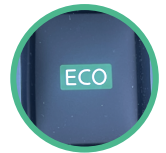
Driving in eco mode increases your range by decreasing acceleration power and increasing regenerative braking when your foot is off the accelerator. To engage ECO mode, press the ECO button, found near the gear shifter.
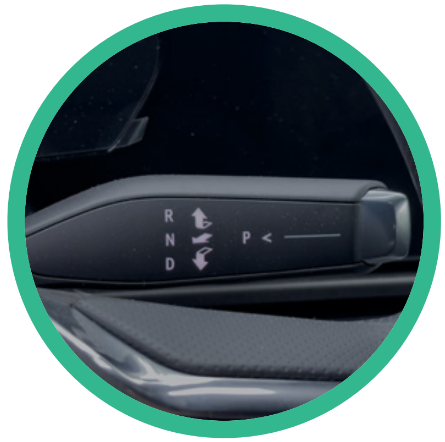
To shift gears, use the lever on the right of the steering wheel. To shift into Drive, pull towards you and down. To shift into reverse, pull towards you and up. Pull straight forward to put the car in neutral. To put the car in park, press the silver button on the end of the lever.
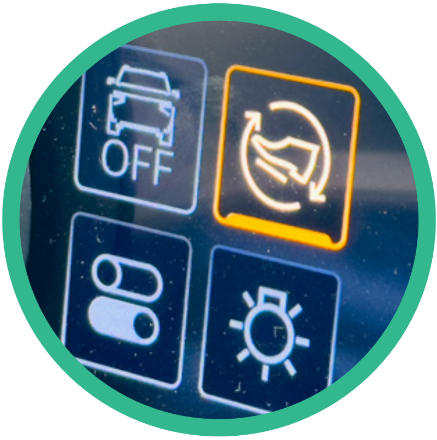
Select One-Pedal driving to increase regenerative braking on your trip. Regenerative braking converts energy from the cars motion back into the battery. To engage, touch the icon on the bottom left of the screen.
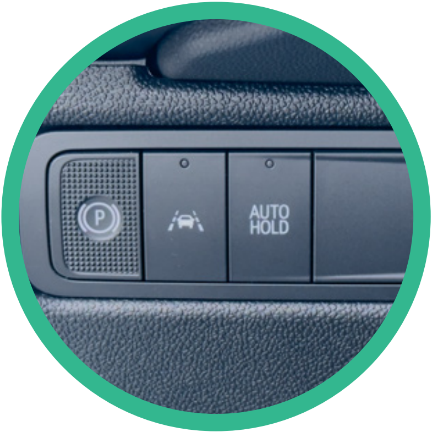
Emergency Brake: The button to engage the parking brake is down and to the left of the steering wheel